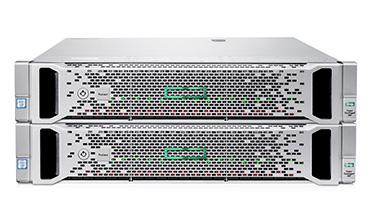HPE Unveils Hyper-Converged Infrastructure Based On ProLiant DL380 Servers

Hewlett Packard Enterprise launched its latest entry into the hyper-converged market, this time with an emphasis on providing an enterprise-grade solution in a market where commodity hardware is the norm.
The new offering, the Hyper Converged 380, combines HPE's enterprise-class DL380 servers and a software stack that includes HPE's StoreVirtual VSA software-defined storage application and the HPE OneView converged management and automation application.
The result is a solution that combines enterprise-class features and scalability with an easy-to-use software stack, said Antonio Neri, HPE's executive vice president.
[The 'Big Boys' Came To Play: HPE, Cisco Shake Up Hyper-Converged Landscape]
"The simplicity of the solution means customers can install virtual machines in just five mouse clicks," Neri told CRN. "Those virtual machines are quickly ready and ready for deploying the application."
Key to that simplicity is the integration of the HPE OneView management software, Neri said. "OneView is at the core of this offering," he said. "It's how we can provision virtual machines in five clicks. ... OpenView has been included in past offerings, but this is the first to spin up virtual machines in five clicks."
The release comes just two weeks after HPE archrival Cisco Systems unveiled its first hyper-converged infrastructure solution, HyperFlex.
HPE, and the former Hewlett Packard from which HPE was spun out, has had a stake planted in the market for hyper-converged infrastructure solutions. The company previously had an agreement to package VMware's EVO:Rail software stack with its ProLiant servers as its first entry into the hyper-converged infrastructure market, but in August 2015 quietly discontinued its EVO:Rail plan.
Neri said that while VMware continues to be a close technology partner for HPE on other product lines, the decision to end the EVO:Rail relationship was due to the large number of vendors that had signed on for the technology. However, he said, HPE could one day implement VMware's more recent Hyper Converged Software stack based on VSAN 6.2.
"EVO:Rail didn't let us differentiate our solution," he said. "But we still have a great relationship. We could use VMware's HCS stack if there's enough differentiation."
HPE, Palo Alto, Calif., replaced EVO:Rail with the HP ConvergedSystem 250-HC StoreVirtual, which combined HPE's Gen9 ProLiant server hardware with its StoreVirtual software.
The 250-HC has good potential, said Dan Molina, CTO at Nth Generation Computing, a San Diego-based solution provider and longtime HPE channel partner. "We are about to close [an] important deal with the 250-HC," he told CRN.
Molina said HPE has done its homework with the new HC 380. "It's definitely on the right track," he said. "The ProLiant DL380 is the world's most-used server," he said. "It's highly reliable, and based on a strong, proven track record."
Many options open up for channel partners with a hyper-converged infrastructure solution based on the DL380 servers, Molina said. "You need a solution with a lot of capacity, the DL380 can do it," he said. Need more SSDs? Yes. Need a wide range of processors? Yes. I think any changes made to the DL380 servers will be supported in the HC 380. I expect some day NVME SSDs will be supported in the HC 380."